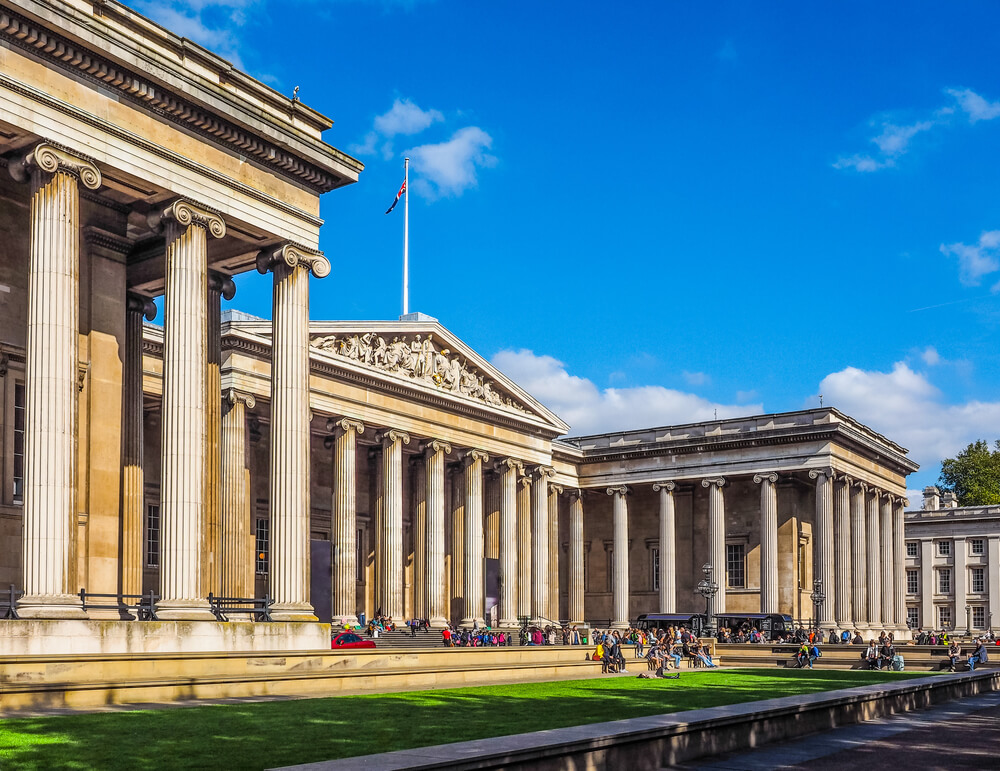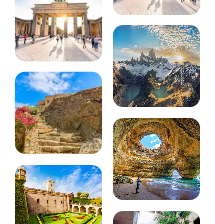Visit the British Museum in London

This institution, which has been sharing sublime treasures of world history with the public since 1830, is a must-see when visiting London. Exhibitions, events and guided tours tell you a little more about the origins of humankind and its evolution.
Millions of objects from all eras, from the four corners of the globe and spread over no fewer than 5 floors await you. There’s plenty to keep you busy on a rainy day!
How do I visit the British Museum?
By bus
The following bus routes are close to the Museum:
-
New Oxford Street: 1, 8, 19, 25, 38, 55, 98, 242
-
Tottenham Court Road (northbound) / Gower Street (southbound): 14, 24, 29, 73, 134, 390
-
Southampton line: 59, 68, X68, 91, 168, 188
By tube
There are 4 underground stations close to the Museum:
-
Tottenham Court Road: 5 minutes’ walk
-
Holborn: 7 minutes’ walk
-
Russell Place: 7 minutes’ walk
-
Goodge Street: 8 minutes’ walk
By bike
There are cycle parks inside the Museum on the Great Russel Street side, and cycle hire facilities nearby.
By car
Take heart, traffic in London is heavy as in all big cities, the nearest car park is in Bloomsbury Square, WC1A 2RJ.
Why visit the British Museum?
This museum offers a comprehensive tour of the history and cultures found all over the world. Whether you’re an art and history enthusiast or just curious, this museum has a wealth of interesting exhibits that are sure to catch your eye at some point.
What can you see at the British Museum?
The British Museum has many rooms spread over 5 floors as follows:
Basements
The basement rooms are dedicated to :
Africa, with prehistoric and contemporary artefacts, masks, sculptures, clothing and items representing the ancestral religion of Vodou.
Not to be missed: the Ivory pendant mask, a major work of African art.
Ground floor
The Age of Enlightenment, between 1680 and 1820, was a period when many discoveries and areas of knowledge were developed in Europe: the discovery of nature and botany, the birth of archaeology, the analysis of the arts and civilisation, the discovery of ancient writings, the study of ancient religions, exploration and trade…
Ancient Greece, marble figurines, gold jewellery, the Parthenon marbles, pottery, amphorae… 1,500 years of history are retraced in this museum.
The Roman Empire, right up to its end in 476 AD, which invaded Europe from Scotland to Constantinople (now Istanbul) and Syria.
Europe and all its changes, the evolution of states and religions, Europe through different eras is represented in several galleries through a large collection of objects, medieval treasures, Celtic art from the Iron Age, the evolution of everyday objects…
North America and its indigenous peoples from Antiquity to the present day: clothing, carved poles, pottery, tools, etc.
Mexico and its history from 2000 BC to the Spanish conquest of the Aztec empire. The Olmec, Maya, Aztec and Mixtec cultures are represented in this gallery by turquoise mosaic sculptures, faces in gold and jade filigree…
6 things not to miss on the ground floor:
-
The Holy Thorn Reliquary: a medieval relic created in Paris and adorned with magnificent precious stones.
-
The David Vases: the oldest white and blue porcelain in the world.
-
Easter Island statue Hoa Hakananai’a: a colossal statue from Easter Island whose civilisation has disappeared.
-
The Rosetta Stone: a fragment of the stele that enabled Jean-François Champollion to decipher hieroglyphics. An invaluable aid for archaeologists.
-
Assyrian Lion Hunt reliefs: an Assyrian engraving depicting a king’s victory in a lion hunt.
-
Parthenon sculptures: different models of marble sculptures from Ancient Greece.
On the upper floors
China and South Asia, 7,000 years of history to explore through a rich collection on writing, rituals, beliefs, trade, etc.
India and its Buddhist sites, their rituals, sculptures, sculpted relief panels depicting narrative scenes from the life of Buddha…
Clocks and watches: go back to the origins of mechanical watchmaking by discovering the very first medieval models, from the simplest to the most complex, marine chronometers, right up to modern watchmaking.
Medieval Europe and its unparalleled treasures, the changes brought about by wars, politics and the evolution of trade. Sacred art gives an idea of how the divine was interpreted at that time.
Japan, from prehistory to the present day, there’s a lot to discover about the Empire of the Rising Sun! From the armour of the great Samurai warriors to manga.
Europe from the 15th to the 19th century.
Europe from the 19th to the 20th century, revolutions and economic growth…
But also: ancient Iran, ancient South Arabia, Anatolia and Urartur, the Etruscan world…
5 things not to miss on the floors
-
The Lewis Chessmen: a chess set dating from the 12th century, probably the most famous in the world.
-
Oxus Treasure: late 19th-century gold and silver objects from Afghanistan.
-
The Royal Game of Ur: or the game of twenty squares, very popular in ancient Mesopotamia.
-
The Portland Vase: a Roman vase from the1st century BC.
-
Samurai armour: traditional Japanese armour from medieval Japan.
Where is the British Museum located?
The British Museum is located in Great Russell Street, London WC1B 3DG.
What are the opening hours of the British Museum?
The opening hours of the British Museum in 2021 are as follows:
-
The museum is open daily from 10.00am to 5.00pm, except on Fridays when it closes at 8.30pm.
-
Some exhibitions are open after 5.00 pm by prior arrangement.
-
The museum is closed from 24 to 26 December and on New Year’s Day.
200 audioguided tours for cities all around the world
Download
